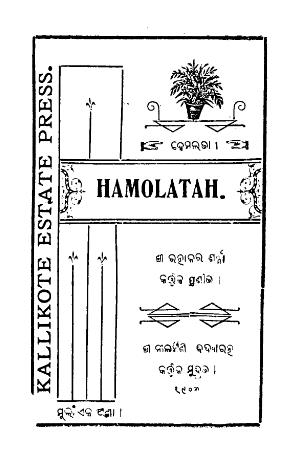Published in 1903, Hemalata by Ratnakara Sharma is a significant work in the realm of Odia literature, showcasing the rich tapestry of emotions and cultural themes prevalent in early 20th-century India. As a poet, Sharma adeptly channels the lyrical beauty of the Odia language, offering readers a window into the intimate world of love, nature, and spirituality. This collection not only highlights Sharma’s poetic brilliance but also reflects the socio-cultural milieu of its time.
At the turn of the 20th century, Odisha was undergoing a renaissance in literature and arts. The impact of British colonial rule was palpable, leading to a resurgence of regional identity and cultural nationalism. In this atmosphere of change, Hemalata emerged as a beacon of Odia poetry, contributing to the growing body of work that sought to express the experiences and aspirations of the Odia people. Sharma, with his keen literary sensibilities, tapped into this cultural current, creating a work that resonates with readers even today.
Hemalata primarily delves into themes of love and nature, intertwining them to explore the human experience. The titular character, Hemalata, symbolizes beauty, purity, and the essence of love itself. Through her, Sharma evokes the myriad emotions associated with longing, desire, and the transcendence of love. The poems often reflect a sense of yearning, capturing fleeting moments of affection and solitude with exquisite detail.
Nature plays a pivotal role in Sharma’s poetry, serving as both a backdrop and a character in its own right. His use of vivid imagery brings the natural world to life, as he draws on the landscapes of Odisha—its rivers, forests, and changing seasons—to express the emotional states of his characters. This connection between the internal and external worlds creates a harmonious balance, allowing readers to experience both the beauty of nature and the depths of human emotion.
Ratnakara Sharma’s writing is marked by its lyrical quality and refined elegance. The rhythmic structure of his verses, combined with the nuanced use of metaphor and simile, enhances the emotional resonance of the poems. The accessibility of his language allows readers to connect easily with the deeper meanings behind the words, making the collection appealing to both casual readers and literary scholars.
The fluidity of Sharma’s style is complemented by the incorporation of traditional Odia poetic forms, which lend authenticity to the work. His ability to blend classical influences with modern sensibilities positions Hemalata as a pivotal piece in the evolution of Odia poetry.
The impact of Hemalata extends beyond its publication. It has inspired generations of poets and writers within the Odia literary tradition, encouraging them to explore similar themes of love and nature. As one of the foundational texts of modern Odia poetry, it has played a crucial role in shaping the trajectory of the genre in Odisha.
Moreover, Hemalata serves as a historical document, reflecting the cultural and emotional landscape of early 20th-century Odisha. Its exploration of personal and universal themes resonates with readers across time, emphasizing the enduring power of love and the natural world.
Books Info
| Books name | Hemalata Part-2 / ହେମଲତା |
| Author | Ratnakara Sharma |
| No Of pages | 33 |
| Publisher | NA |
| Publication | 1903 |
| Printed At | Sri Nilamani Bidyaratna |
| Distributor | NA |

